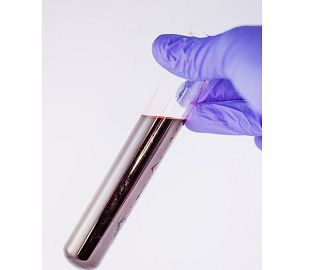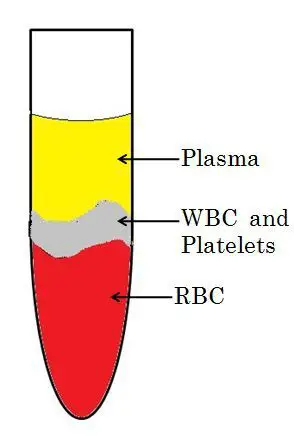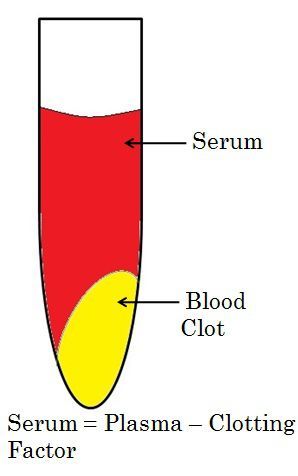Plasma is that part of the blood, which contains blood clotting agent called as fibrinogen, while serum is the fluid part of the blood and does not contain clotting agent. The plasma and serum can be extracted from the centrifugation of blood. The serum is obtained after the clotting of blood, while plasma can be obtained before the coagulation of the blood. Centrifugation separates the blood components by its weight, size, and density.
The fluid circulating in the body through arteries and veins is called as blood. It is an important part of the body’s immune system which supplies oxygen to the tissue and takes the carbon dioxide to get excreted.
The another important role of blood is to provide nutrients, hormones, electrolytes to the cell. Blood is composed of white blood cells, red blood cells, and platelets, floating in the liquid called the plasma. It is said that blood makes up the 8% of the total body weight.
So blood plays the role of connective tissue having the liquid matrix, carrying the cells and another liquid part. In the provided article we will discuss the difference between plasma and serum, and their functions.
Content: Plasma Vs Serum
Comparison Chart
| Basis for Comparison | Plasma | Serum |
|---|---|---|
| Meaning | Plasma is the watery fluid portion of the blood, in which several blood cells are diluted and is obtained after the centrifugation by adding the anticoagulating agents. | The fluid or undiluted part of the blood, obtained after the complete coagulation of the blood, without adding an anticoagulating agent. |
| Type | Plasma is liquid. | The serum is fluid. |
| Fibrinogen | Present. | Absent. |
| Anticoagulant | Needed (EDTA, Heparin). | Not needed. |
| From where it is obtained | Plasma is obtained, through the process of spinning of blood before clotting. Plasma is easily collected. | The serum is obtained, through the process of spinning of blood after clotting. Though serum is harder to separate. |
| Composition | Plasma is the yellow part of the liquid which is 55% of the total volume of blood. | Serum contains the remaining part of blood, which is less than the plasma. |
| Plasma carries serum and clotting factors. | Serum lacks the clotting factors. |
|
| Other blood components like vitamins, regulatory proteins, hormones, electrolytes. | Antibodies, antigens, hormones, electrolytes and proteins. |
|
| Plasma contains antibodies, a kind of protein to fight against the foreign body. | The serum also contains antibodies, to cross-react with the recipient antigen. |
|
| Volume | 55% of the total blood is plasma. | The serum is less in volume comparatively. |
| Density | Plasma has the density of approximately 1.025 g/ml, or 1025 kg/m3. | The serum has the density of 1.024 g/ml. |
| Use | Plasma supports the transportation of materials like glucose and other nutrients through the blood. | The animal serum is used as anti-toxins, anti-venom and for vaccinations. |
| Plasma helps in regulation of body temperature and maintenance of blood pressure. | The serum is used in diagnosing the cholesterol, proteins, sugar level, etc., present in the blood. | |
| Plasma is used mostly problems relates to blood-clotting. | The serum is also used in blood typing. |
Definition of Plasma
Plasma is the liquid part of the blood where the components like hormones, cells, and nutrients float. More than half of the volume of the total blood is covered by plasma. It contains fibrinogen which is a clotting agent and helps in preventing excessive flow of blood in case of injury.
The composition of the plasma includes albumin, globulin, hormones, gases, nitrogenous waste, nutrients and amino acids. When the blood sample is spun in a centrifuge, the upper layer which is obtained in the blood sample is called the plasma.
Functions: Plasma also contains proteins which are helpful in the transportation of materials through blood to various parts of the body such as glucose and other nutrients. Plasma helps in regulation of body temperature and in controlling the blood pressure.
The blood also used in the transfusion, especially in the case of hemophilia or other blood clotting disorders, burns, immunodeficiency. Plasma is separated from the blood, for the purpose of increasing the longevity up to years and can be easily carried from one place to another.
To understand directly- let’s perform an experiment – By taking a small amount of blood sample in a test tube, and we allow to centrifuge it for some time, but before going for the centrifugation, add an anti-coagulating agent like heparin or EDTA.
The components will be separated on the basis of their weight and density and will get divided into three parts, the lowermost part is known as RBC or red blood cells, which occupies the 45% of the total sample. About 1% layer above that is WBC or white blood cells and platelets, which is present just above the layer of RBC and the top most layer consist of plasma, which is more than half of the volume of the total blood sample .i.e., around 55% and is of yellow colour.
Basically, we are interested in plasma, that contains the 90% of water, 8% of proteins (albumin, globulin, and fibrinogen-clotting factor) and 2% regulatory proteins, electrolytes, nutrients, hormones, gases.
The most important thing is that we added before the centrifugation was the anticoagulant like heparin and EDTA, which is used to avoid clotting to get plasma in the liquid state.
Definition of Serum
Apart from plasma, there is an another constituent present in the blood called as serum. It is the fluid part of the blood and does not contain the blood clotting factor or blood cells. In fact, it is the resources for proteins, antigens, antibodies (IgG, IgM, IgE, IgD, IgA), electrolytes and hormones. It is helpful in diagnosing the diseases such as cholesterol, sugar, blood pressure, etc., and also in blood typing.
The serum is obtained from the same above experiment, described above for obtaining plasma, but if we do not add any anticoagulant and allowed the blood to clot, by keeping it for 30 mints after centrifugation. The upper layer which is obtained is serum, and the layer which got settled at the bottom is the clotted blood.
Most importantly all the components of the blood are same as that of plasma like the water, electrolytes, nutrients, vitamins, nutrients, hormones, gases but it devoid of the fibrinogen. This is the primary factor which distinguishes them.
Key Differences Between Plasma and Serum
- The Plasma is the watery or liquid fluid portion of the blood, in which several blood cells are diluted and is obtained after the centrifugation by adding the anti-coagulating agents. The fluid or undiluted part of the blood, obtained after the complete coagulation of the blood, without adding an anticoagulating agent is called as serum.
- Fibrinogen is present in the plasma, and it is absent in serum.
- The anticoagulant agent like EDTA, Heparin is needed while centrifugation process to separate plasma from other blood components, but it is not necessary for the serum to separate.
- Plasma is obtained, through the process of spinning of blood, and it gets separates easily whereas serum is obtained, through the process of spinning of blood after clotting, though serum is more difficult to separate.
- Composition of plasma is the yellow part of the liquid which is 55% of the total volume of blood, carrying serum and clotting factors, water, albumin, and globulin whereas serum contains the very less part of blood, though lacks the clotting factors, it also contains antibodies, antigens, hormones, electrolytes, water, proteins, and antibodies, in order to cross-react with the recipient antigen
- The volume of the plasma is 55% of the total blood, and density is approximately 1.025 g/ml, or 1025 kg/m3, whereas serum is less in volume comparatively having the density of 1.024 g/ml.
- Plasma supports the transportation of materials like glucose and other nutrients through the blood; It also helps regulation of body temperature and in the maintenance of blood pressure. Plasma is used mostly problems relates to blood-clotting. The animal serum is used as antitoxins, anti-venom and for vaccinations. It is also used in diagnosing the cholesterol, proteins, sugar level, etc., present in the blood. The serum is also used in blood typing.
Conclusion
We can say that blood which is one of the most important parts of the body and helps in transportation of nutrients, hormones, gases, vitamins, etc. and thus connecting each section. The blood contains three important components like – plasma, white blood, and red blood cells. We discuss the fundamental difference between the plasma and serum and how can be they separated. We also consider their uses and importance.




Rwanda adam says
It helped me on my carrier as a medical laboratory scientist
M.Raman says
I Love this site because of easy and understandable content.
Thanks. for such great content
K Rambabu says
The information provided here is very helpful and i have gained a lot knowledge about the importance of serum and plasma. Thank you very much for the data .
Mino says
I’m very grateful for this information. It is very useful. Thank you. 🙂